| Solar eclipse of May 10, 2013 | |
|---|---|
 Annularity viewed from Churchills Head, Australia. | |
 Map | |
| Type of eclipse | |
| Nature | Annular |
| Gamma | −0.2694 |
| Magnitude | 0.9544 |
| Maximum eclipse | |
| Duration | 363 sec (6 m 3 s) |
| Coordinates | 2°12′N 175°30′E / 2.2°N 175.5°E |
| Max. width of band | 173 km (107 mi) |
| Times (UTC) | |
| (P1) Partial begin | 21:25:10 |
| (U1) Total begin | 22:30:34 |
| Greatest eclipse | 0:26:20 |
| (U4) Total end | 2:19:58 |
| (P4) Partial end | 3:25:23 |
| References | |
| Saros | 138 (31 of 70) |
| Catalog # (SE5000) | 9537 |
An annular solar eclipse took place at the Moon's descending node of the orbit on May 9–10 (UTC), 2013,[1][2] with a magnitude of 0.9544. A solar eclipse occurs when the Moon passes between Earth and the Sun, thereby totally or partly obscuring the image of the Sun for a viewer on Earth. An annular solar eclipse occurs when the Moon's apparent diameter is smaller than the Sun's, blocking most of the Sun's light and causing the Sun to look like an annulus (ring). An annular eclipse appears as a partial eclipse over a region of the Earth thousands of kilometres wide.
It was the 31st eclipse of the 138th Saros cycle, which began with a partial eclipse on June 6, 1472 and will conclude with a partial eclipse on July 11, 2716.
Visibility
Animation of eclipse path |
Annularity was visible from a 171 to 225 kilometre-wide track that traversed Australia, eastern Papua New Guinea, the Solomon Islands, and the Gilbert Islands, with the maximum of 6 minutes 3 seconds visible from the Pacific Ocean east of French Polynesia.
Images
 Simulation of greatest annularity east of Marakei, Kiribati.
Simulation of greatest annularity east of Marakei, Kiribati. Anthony Lagoon, Australia, 22:20 GMT (May 9)
Anthony Lagoon, Australia, 22:20 GMT (May 9).jpg.webp) Partial from Manly Beach, New South Wales, 22:30 GMT (May 9)
Partial from Manly Beach, New South Wales, 22:30 GMT (May 9)_(8724726923).jpg.webp) Partial from Docklands, Victoria, 22:49 GMT (May 9)
Partial from Docklands, Victoria, 22:49 GMT (May 9).jpg.webp) Partial from Rockhampton, Queensland, 22:57 GMT (May 9)
Partial from Rockhampton, Queensland, 22:57 GMT (May 9).jpg.webp) Bairiki, Kiribati, 0:15 GMT
Bairiki, Kiribati, 0:15 GMT Eclipse shadows from a coconut leaf shadow. From Tarawa, Kiribati at 0:30 GMT
Eclipse shadows from a coconut leaf shadow. From Tarawa, Kiribati at 0:30 GMT Partial from Waikiki, Hawaii, 2:12 GMT
Partial from Waikiki, Hawaii, 2:12 GMT
Related eclipses
Eclipses of 2013
- A partial lunar eclipse on April 25.
- An annular solar eclipse on May 10.
- A penumbral lunar eclipse on May 25.
- A penumbral lunar eclipse on October 18.
- A hybrid solar eclipse on November 3.
Solar eclipses 2011–2014
This eclipse is a member of the 2011–2014 solar eclipse semester series. An eclipse in a semester series of solar eclipses repeats approximately every 177 days and 4 hours (a semester) at alternating nodes of the Moon's orbit.[3][Note 1]
| Descending node | Ascending node | |||||
|---|---|---|---|---|---|---|
| Saros | Map | Gamma | Saros | Map | Gamma | |
118.jpg.webp) Partial from Tromsø, Norway |
2011 June 01 Partial (north) |
1.21300 | 123 Hinode XRT footage |
2011 November 25 Partial (south) |
−1.05359 | |
128 Middlegate, Nevada |
2012 May 20 Annular |
0.48279 | 133.jpg.webp) Cairns, Australia |
2012 November 13 Total |
−0.37189 | |
138 Churchills Head, Australia |
2013 May 10 Annular |
−0.26937 | 143 Partial from Libreville, Gabon |
2013 November 03 Hybrid |
0.32715 | |
148_cropped.jpg.webp) Partial from Adelaide, Australia |
2014 April 29 Annular (non-central) |
−0.99996 | 153 Partial from Minneapolis |
2014 October 23 Partial (north) |
1.09078 | |
Saros 138
It is a part of Saros cycle 138, repeating every 18 years, 11 days, containing 70 events. The series started with partial solar eclipse on June 6, 1472. It contains annular eclipses from August 31, 1598 through February 18, 2482 with a hybrid eclipse on March 1, 2500. It has total eclipses from March 12, 2518 through April 3, 2554. The series ends at member 70 as a partial eclipse on July 11, 2716. The longest duration of totality will be only 56 seconds on April 3, 2554.
| Series members 25–35 occur between 1901 and 2100: | ||
|---|---|---|
| 25 | 26 | 27 |
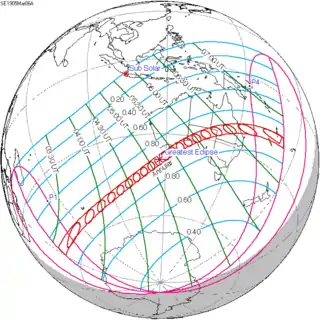 March 6, 1905 |
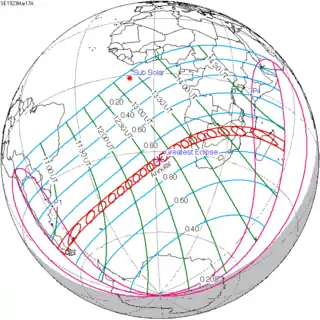 March 17, 1923 |
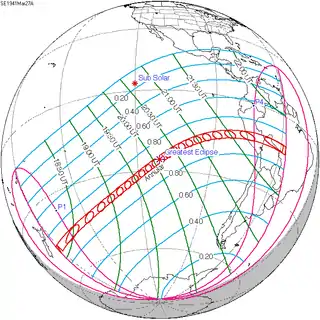 March 27, 1941 |
| 28 | 29 | 30 |
 April 8, 1959 |
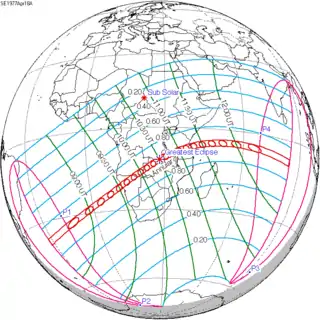 April 18, 1977 |
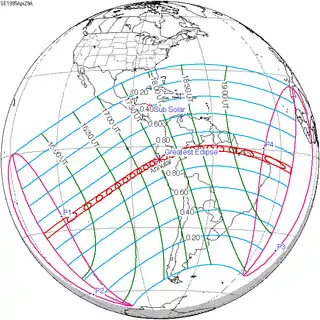 April 29, 1995 |
| 31 | 32 | 33 |
 May 10, 2013 |
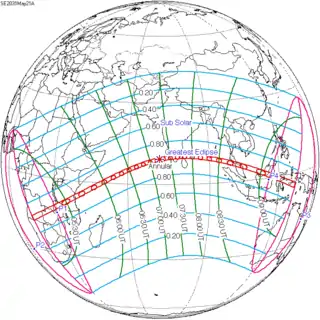 May 21, 2031 |
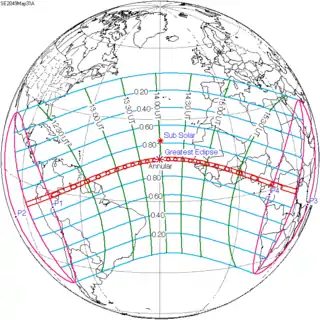 May 31, 2049 |
| 34 | 35 | |
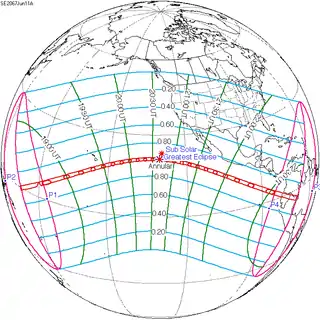 June 11, 2067 |
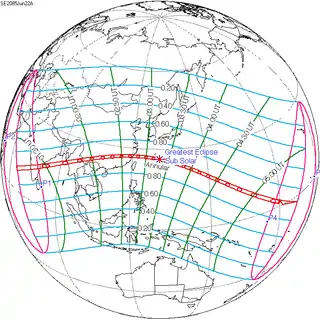 June 22, 2085 | |
Inex series
This eclipse is a part of the long period inex cycle, repeating at alternating nodes, every 358 synodic months (≈ 10,571.95 days, or 29 years minus 20 days). Their appearance and longitude are irregular due to a lack of synchronization with the anomalistic month (period of perigee). However, groupings of 3 inex cycles (≈ 87 years minus 2 months) comes close (≈ 1,151.02 anomalistic months), so eclipses are similar in these groupings.
| Inex series members between 1901 and 2100: | ||
|---|---|---|
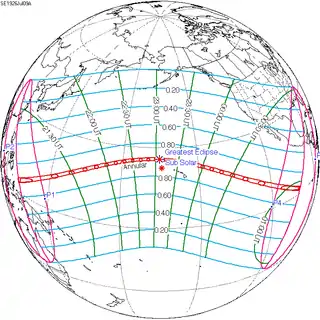 July 9, 1926 (Saros 135) |
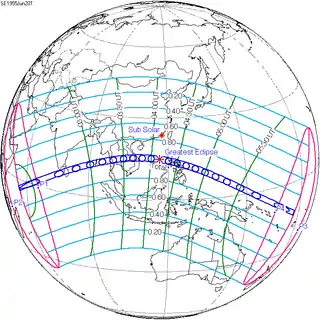 June 20, 1955 (Saros 136) |
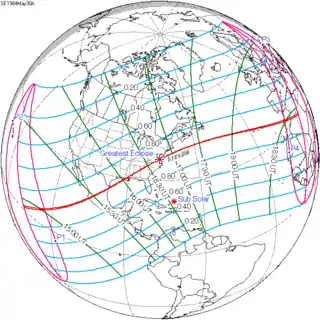 May 30, 1984 (Saros 137) |
 May 10, 2013 (Saros 138) |
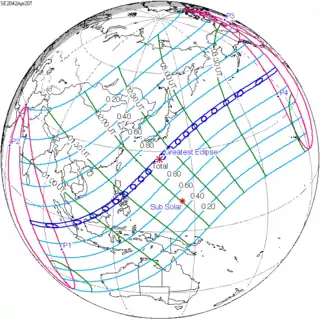 April 20, 2042 (Saros 139) |
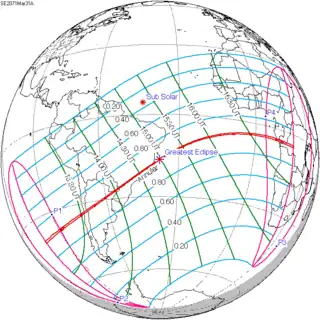 March 31, 2071 (Saros 140) |
 March 10, 2100 (Saros 141) |
||
Tritos series
This eclipse is a part of a tritos cycle, repeating at alternating nodes every 135 synodic months (≈ 3986.63 days, or 11 years minus 1 month). Their appearance and longitude are irregular due to a lack of synchronization with the anomalistic month (period of perigee), but groupings of 3 tritos cycles (≈ 33 years minus 3 months) come close (≈ 434.044 anomalistic months), so eclipses are similar in these groupings.
| Series members between 1801 and 2100 | |||
|---|---|---|---|
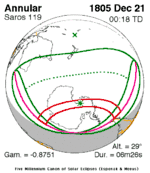 December 21, 1805 (Saros 119) |
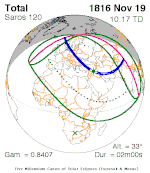 November 19, 1816 (Saros 120) |
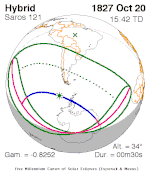 October 20, 1827 (Saros 121) | |
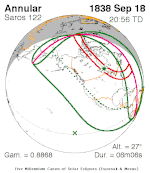 September 18, 1838 (Saros 122) |
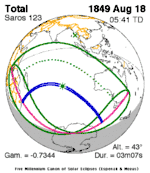 August 18, 1849 (Saros 123) |
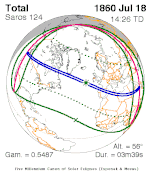 July 18, 1860 (Saros 124) | |
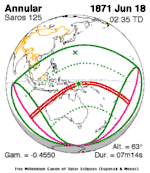 June 18, 1871 (Saros 125) |
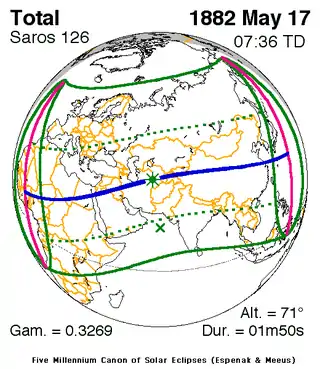 May 17, 1882 (Saros 126) |
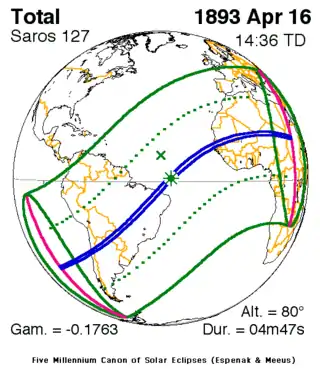 April 16, 1893 (Saros 127) | |
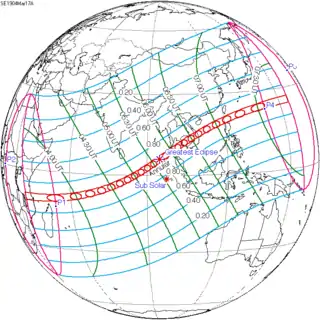 March 17, 1904 (Saros 128) |
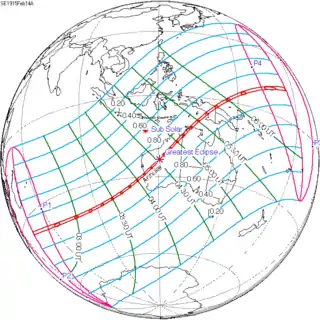 February 14, 1915 (Saros 129) |
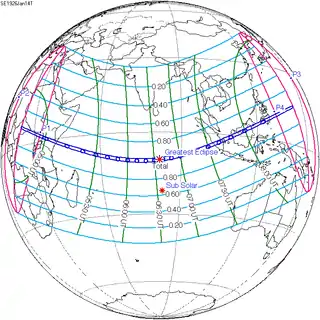 January 14, 1926 (Saros 130) | |
 December 13, 1936 (Saros 131) |
 November 12, 1947 (Saros 132) |
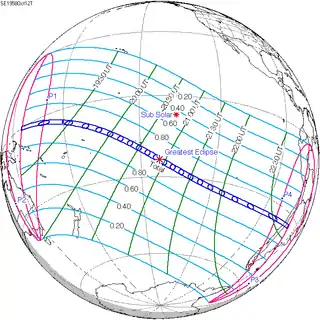 October 12, 1958 (Saros 133) | |
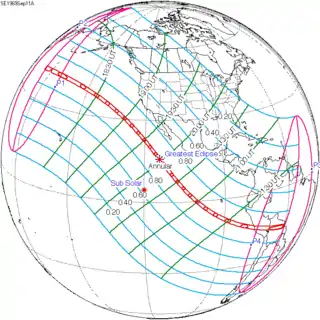 September 11, 1969 (Saros 134) |
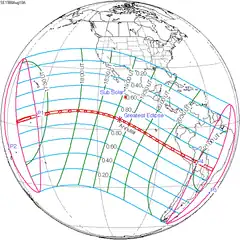 August 10, 1980 (Saros 135) |
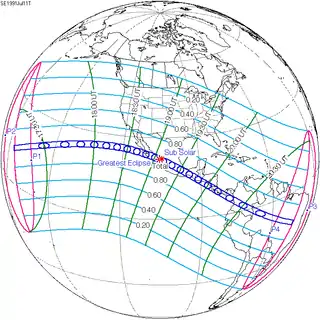 July 11, 1991 (Saros 136) | |
 June 10, 2002 (Saros 137) |
 May 10, 2013 (Saros 138) |
 April 8, 2024 (Saros 139) | |
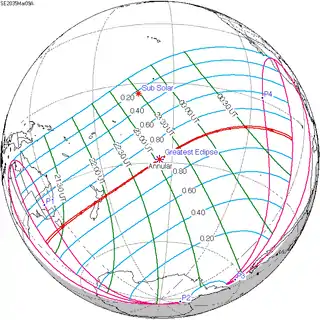 March 9, 2035 (Saros 140) |
 February 5, 2046 (Saros 141) |
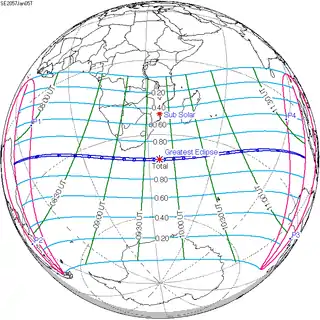 January 5, 2057 (Saros 142) | |
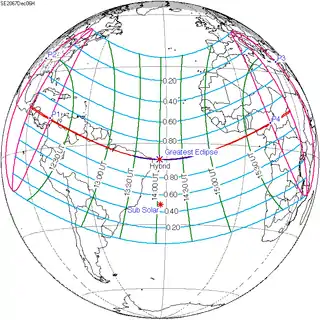 December 6, 2067 (Saros 143) |
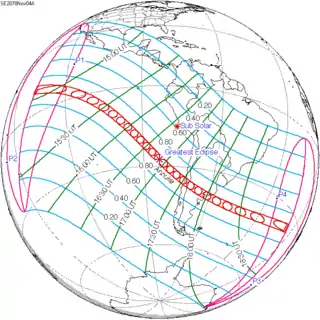 November 4, 2078 (Saros 144) |
 October 4, 2089 (Saros 145) | |
 September 4, 2100 (Saros 146) |
|||
In the 22nd century:
- Solar saros 147: annular solar eclipse of August 4, 2111
- Solar saros 148: total solar eclipse of July 4, 2122
- Solar saros 149: total solar eclipse of June 3, 2133
- Solar saros 150: annular solar eclipse of May 3, 2144
- Solar saros 151: annular solar eclipse of April 2, 2155
- Solar saros 152: total solar eclipse of March 2, 2166
- Solar saros 153: annular solar eclipse of January 29, 2177
- Solar saros 154: annular solar eclipse of December 29, 2187
- Solar saros 155: total solar eclipse of November 28, 2198
In the 23rd century:
- Solar saros 156: annular solar eclipse of October 29, 2209
- Solar saros 157: annular solar eclipse of September 27, 2220
- Solar saros 158: total solar eclipse of August 28, 2231
- Solar saros 159: partial solar eclipse of July 28, 2242
- Solar saros 160: partial solar eclipse of June 26, 2253
- Solar saros 161: partial solar eclipse of May 26, 2264
- Solar saros 162: partial solar eclipse of April 26, 2275
- Solar saros 163: partial solar eclipse of March 25, 2286
- Solar saros 164: partial solar eclipse of February 22, 2297
Metonic cycle
The metonic series repeats eclipses every 19 years (6939.69 days), lasting about 5 cycles. Eclipses occur in nearly the same calendar date. In addition, the octon subseries repeats 1/5 of that or every 3.8 years (1387.94 days). All eclipses in this table occur at the Moon's descending node.
| 21 events between July 22, 1971 and July 22, 2047 | ||||
|---|---|---|---|---|
| July 21–22 | May 9–11 | February 26–27 | December 14–15 | October 2–3 |
| 116 | 118 | 120 | 122 | 124 |
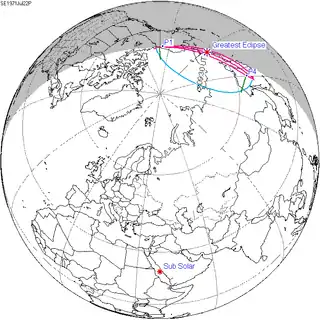 July 22, 1971 |
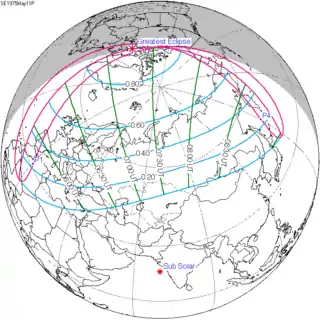 May 11, 1975 |
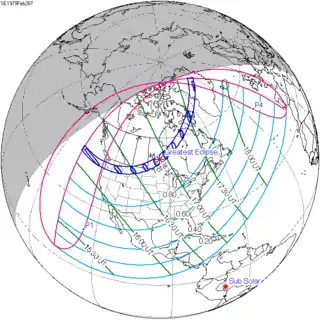 February 26, 1979 |
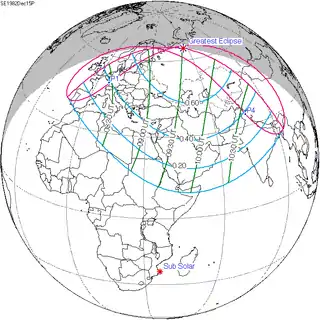 December 15, 1982 |
 October 3, 1986 |
| 126 | 128 | 130 | 132 | 134 |
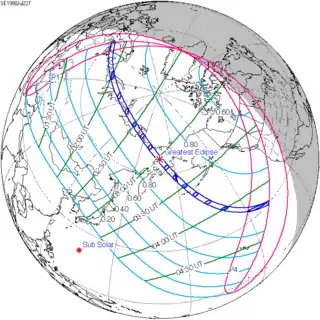 July 22, 1990 |
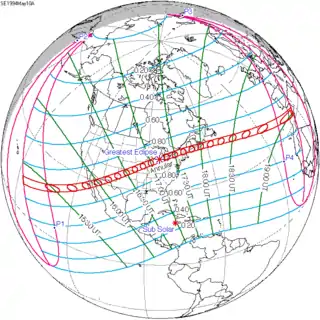 May 10, 1994 |
 February 26, 1998 |
 December 14, 2001 |
 October 3, 2005 |
| 136 | 138 | 140 | 142 | 144 |
 July 22, 2009 |
 May 10, 2013 |
 February 26, 2017 |
 December 14, 2020 |
 October 2, 2024 |
| 146 | 148 | 150 | 152 | 154 |
 July 22, 2028 |
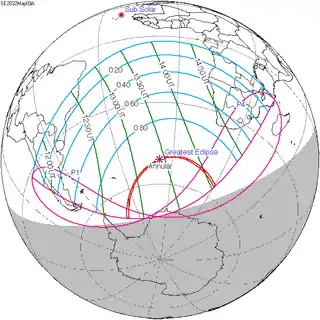 May 9, 2032 |
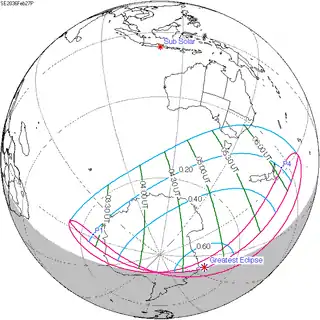 February 27, 2036 |
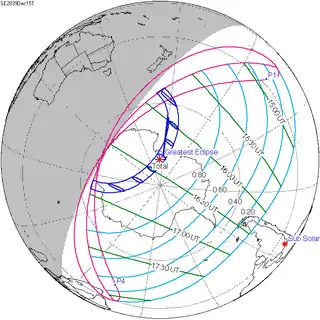 December 15, 2039 |
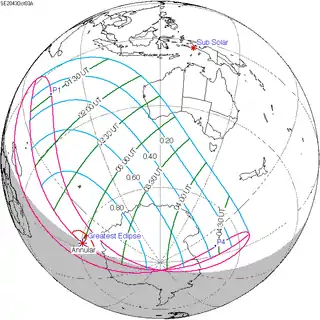 October 3, 2043 |
| 156 | ||||
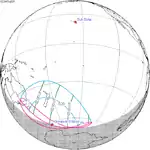 July 22, 2047 | ||||
References
- ↑ "Aussies see 'ring of fire' eclipse". Pacific Daily News. 2013-05-11. p. A10. Retrieved 2023-10-26 – via Newspapers.com.
- ↑ ""Ring of fire' eclipse crosses Australia, Pacific". The Galion Inquirer. 2013-05-11. p. 3. Retrieved 2023-10-26 – via Newspapers.com.
- ↑ van Gent, R.H. "Solar- and Lunar-Eclipse Predictions from Antiquity to the Present". A Catalogue of Eclipse Cycles. Utrecht University. Retrieved 6 October 2018.
- ↑ The partial solar eclipses of January 4, 2011 and July 1, 2011 occurred in the previous semester series.
- Earth visibility chart and eclipse statistics Eclipse Predictions by Fred Espenak, NASA/GSFC
- Photos:
- Cape York Annular Eclipse APOD, 5/11/13
- Partial Solar Eclipse with Airplane APOD, 5/13/13
.jpg.webp)